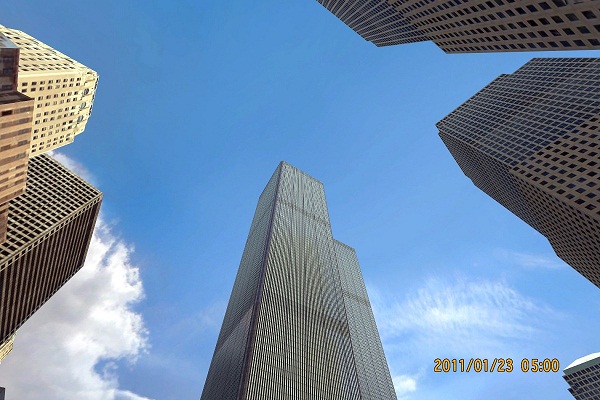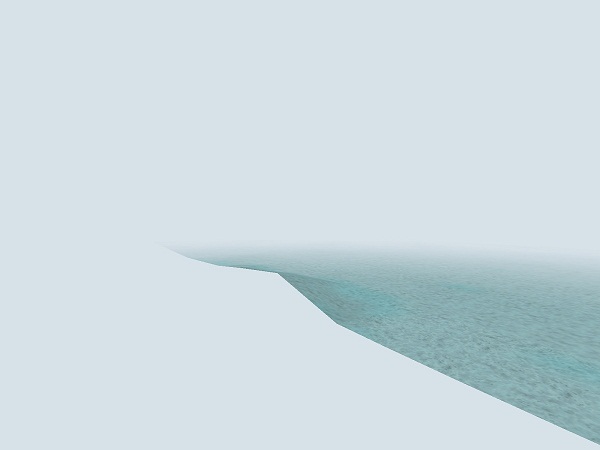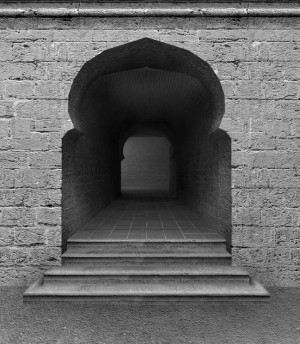Artist of the Week 09/05 – 09/11: Oliver Warden Conveys an Analogous Reality through Otherworldly Video Game Art
GALO: Since your work disassociates the camera from photography, how do you consider “camera-less photography” qualifying as photography, and what is your artistic process?
OW: It’s making photographic images by not using a camera. Photography is the tool of documentation. For me, the screen grabs documents, the pixel replaces the grain, and the monitor becomes the camera as a porthole into “the other world.” I manipulate the screen grab in Photoshop, using motifs from the history of photography, and then print it on archival paper. People’s faces drop when they realize what they’re looking at isn’t real, even though they’ve invested in it as being real. They’ve had an authentic emotional and intellectual response, but then question their own experience. Truth in photography is tough. The ultimate question is: “how do we see?” The camera is a construct, reflecting the mind’s eye.
GALO: Rumor has it that you play upwards of 40 hours of video games a week in order to find your artistic subjects. How do you know when you’ve found something worthy of an art piece?
OW: Forty is nothing. I make art; it’s my work, my passion, and my recreation. If I was, say, a book editor reading 40 hours a week you’d think, ‘Of course, yeah, that makes sense.’ It’s the same thing. I’m looking for inspiration that sits outside of the designer’s intentions and the game’s objectives. This usually manifests itself as something off the playable area, a breakdown in the game’s design, or more importantly, a moment or action that inspires contemplation or discovery exterior to the gameplay. This all usually happens after playing for hundreds of hours. I literally exhaust all the possibilities and then, if I’m paying attention, something unique emerges, and often it’s art. In other words, I start playing not as a gamer, but as an artist. It’s a weird moment when that transference occurs.
GALO: Your black and white No Man’s Land and Respawn series are markedly different from your other works. What inspired their distinctly somber and ominous tones?
OW: In 2006, I started making artwork from the game Counter-Strike: Source (Valve). I wanted to contribute to the rich history of making art during wartime and I thought using a war simulator would be an interesting way to address fluctuating moments during the war in Iraq. The first body of work, titled No Man’s Land (2006), featured images of closed doors and abandoned hallways. I wanted to lock the viewer into the immobility of a photograph of a space that was usually interactive. I followed up in 2008 with a new trio of pieces entitled Respawn. During the presidential race, McCain and Obama were both promising resolution to the war in Iraq, the first through victory and The Surge, and the second through withdrawal and hope. I created three “lights at the end of the tunnel” to illustrate their ambitions but entitled them The Pledge, The Turn, and The Prestige, which are the three motions in a magic act. The Prestige appeared at Danziger Projects (now Danziger Gallery) in January 2010, along with Rush DD.

A picture of the Twin Towers by Oliver Warden. Photo Courtesy of: Oliver Warden.
GALO: Your photograph of the World Trade Center is printed on Kodak Endura paper, making it look and feel like an actual photograph, perhaps to a disturbing effect. Is that why you decided to include the date and time?
OW: The World Trade Center image came from an Australian designer, David Boddy, who was creating a virtual map of the scene of 9/11. I contacted him, asking to have the image, but removed everything else, except for what remains in the picture now. Being able to imagine a world in which the Towers still existed was powerful to me. It’s a representation of an alternate reality.
GALO: You’ve stalked people in Central Park at midnight to “capture” them on video, lived in a school wall for a week, and sat inside a chair while people unknowingly sat on your lap. What kind of artistic boundaries are you looking to cross or challenge? Is discomfort or “taboo” something you generally and deliberately involve in your work?
OW: I would never hurt anyone physically, but I do want to destroy your idea of what art is; it’s my lifelong ambition. Video games, the Internet and all online experiences, change how we see [things], which in turn affects the ideas we create and the stories we tell. Understanding “how we see” has been a pursuit of art, and of course, a cornerstone of photography for 150 years. So, in a sense, I’m conservatively upholding a tradition. Where it becomes liberating and challenging is how we match the expansion of our perception with our consciousness. In my work, ignoring the objective of a game becomes a metaphor for questioning authority, including our own. In other words, how do we understand our intellectual and emotional responses to an image of something we think is real, when we learn shortly after that it is false? What does that mean in terms of the authenticity of our experience? I hope [that by] making people question their firm understanding of “the real” [it becomes] discomforting.

“Edge of the World” by Oliver Warden. Photo Courtesy of: Oliver Warden.
GALO: Your first series, Edge of the World, seems to most explicitly reference its basis in video games. How did it develop?
OW: Inside the game Tribes, there was usually a football field sized arena where all the game play would occur. After I played that to exhaustion, I spent hundreds of hours exploring the vast landscapes surrounding the area that the designers would plop the playable arena onto. This had nothing to do with the original intention of the game or its objectives, but I enjoyed not having any goals, except to explore. I came across many things out there, weird breakdowns in the game’s geometry, coding bugs, and even discarded items by the designers themselves (Twin Monoliths). The thing I discovered that was the most interesting was the edge of the world; the maps were limited and actually stopped and beyond that was an infinite fall into oblivion. Even though this was part of the original design of the maps, coming across this place that man had mythologized and searched for thousands of years inside this virtual space, [it] was an odd sensation. I think it spoke to how immersed inside the spaces I felt. The sensation was not unlike the sensation of real discovery, like finding a jewel in a junkyard or something of sentiment in a ghost town. To make this body of work, I shot nearly 1,600 images and settled on 14. My final collection of shots of the edge of the world and the monoliths, best captured my sensation of discovery.
As I dug deeper, my emotions and “otherly” sensations started to become profound, and I began to think of it in terms of the search for the sublime. Inspired by the works of [landscape artist] Frederick Church, I saw this as an opportunity to see the sublime in relation to fictional landscapes (Heart of the Andes, 1859). As my emotions grew deeper, I also felt like referring to this space as “virtual reality,” as the outdated “cyber space” was inadequate. I started calling it “The Other World,” and still do to this day. Therefore, I feel one’s computer monitor is simply a porthole on which to look at the other world. In addition, if you think of these spaces as reflections of our mind’s eye, of our collective desires and imagination, then one could argue that the other world is this world, and I do, all the time.

“The Edge of the World” series by Oliver Warden. Photo Courtesy of: Oliver Warden.
GALO: Are you working on any new upcoming projects?
OW: Right now, I’m putting together a four part installation using four locations from four different games. Luckily, the tides are turning and video games are finally entering into the commercial and alternative gallery spaces. Hopefully, I can find a space that [is] interested in presenting this new, exciting way to see the other world. Also, a new work entitled, The New Mountain will be in a group show at Storefront Bushwick on the 21st of September.
Oliver Warden will be one of the participating Brooklyn-based artists in the GO Brooklyn fest located across various locations around Brooklyn as well as at the Brooklyn Museum (located at 200 Eastern Parkway, Brooklyn, New York 11238-6052), this weekend, September 8-9, 2012 from 11 a.m. to 7 p.m. For a list of locations and more information please visit http://www.gobrooklynart.org and http://www.brooklynmuseum.org.


